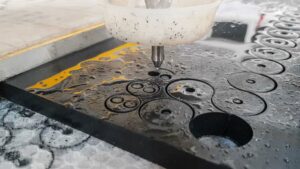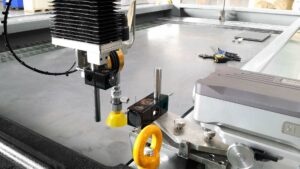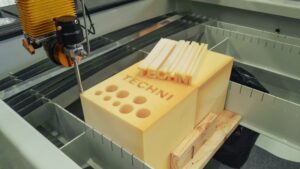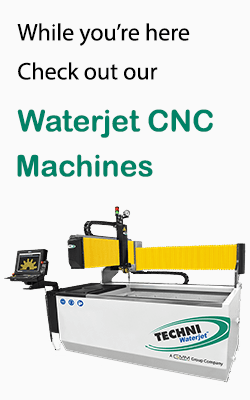Waterjet has been the favorite cutting process in a wide range of sectors in the manufacturing world, over alternatives like laser cutting.
However, certain professionals are still new to the technology and in the early stages of adoption for their industry. One common question that comes up frequently from these professionals is, ‘what is the correct water jet cutting pressure?’
This article discusses all the details regarding waterjet cutting pressure. You will also learn what influences the pump you require and the difference between a hyperpressure and a normal pressure pump.
What is the Average Pressure of a Water Jet Cutter?
Understanding the average waterjet cutting pressure means knowing the typical range within which it can vary. There is no single value for pressure because of the variations that can occur based on several variables.
Water pressure for waterjet cutting starts at 30,000 psi (210 MPa) and goes up to 90,000 psi (620 MPa).
Effect of Pressure on Cutting Thickness
Since abrasive waterjet cutting machines use high-pressure water for piercing the materials, many people wrongly believe that using higher pressure will cut greater thicknesses of material. However, that is an incorrect assumption.
A 30,000 psi machine can cut the same material thickness as a 90,000 psi machine. However, higher pressures provide a significantly faster cutting speed, increasing productivity exponentially. Additionally, increasing the water pressure of the jet stream increases the accuracy of this cold-cutting process.
Factors That Influence Water Jet Cutter Pressure
Here are the factors that influence the water pressure of a waterjet cutter:
Horsepower
When buying a pump, most people focus on the water stream pressure. However, the horsepower of the pump is also a critical factor one should consider. The horsepower determines the pressure required at a given flow rate, and is derived from the formulae:
Horsepower = Pressure x Flow Rate
Therefore, for a given pump horsepower, increased water pressure results in decreased flow rate. To compensate, the water jet will need a smaller nozzle orifice.
Productivity
As mentioned earlier, an increase in the nozzle pressure will increase the cutting speed. The suggestion is that increasing productivity is easy by using higher pressures. That is true, but only up to 50,000 psi to 60,000 psi.
Beyond that, with hyper-pressure pumps. The waterjet cutting speed increases with pressure, but so does the equipment wear and tear, leading to frequent breakdowns of the waterjet system, resulting in downtime – which can lower operational productivity.
Abrasive
In abrasive waterjet cutting, the choice of abrasive grains can also dictate the most effective water pressure. Finer mesh abrasives allow using narrower nozzle orifices without clogging them, increasing the output pressure at the nozzle.
80 mesh abrasive is usually suitable for most requirements. In high-precision cutting, 120 mesh abrasive is the recommended choice. A 120 mesh abrasive material also provides a better quality cut when cutting thin materials.
Appropriate abrasive hardness leads to creating high efficiency without increasing pressure. For instance, using super-hard materials like aluminum oxide as an abrasive means an increased cutting speed for hard materials. However, it also leads to faster wear of the mixing tube and other components.
Super-hard abrasives are not required to cut soft materials like aluminum and gold. Normal abrasives such as garnets are adequate for cutting soft materials.
Water Velocity
The waterjet cutting process occurs due to the high velocity of the jet stream. Many people use water velocity and pressure interchangeably, but that shouldn’t be the case. The velocity of the water jets varies depending on the pressure and the nozzle orifice. Increasing water velocity at a fixed pressure is possible by decreasing the orifice size. However, the size of the garnet abrasive used subsequently limits the diameter of the orifice.
Therefore, the easier way to extract high-speed water is by increasing the water pressure. It is important to note that increased water velocity will only increase the cutting speed but not the thickness of the materials it can cut. Additionally, water jet speeds govern the speed of the garnet since it travels in the stream.
Multiple Cutting Heads
Professionals often use multiple cutting heads to increase productivity without increasing water pressure in hyperpressure operations. However, while production speed increases, a high horsepower pump is also required to provide adequate pressurizing for the individual cutting head.
Additionally, parts of the individual cutting heads, such as the waterjet nozzle, will deteriorate at their own rate, leading to inaccuracy when cutting materials since the wear and tear on each cutting head will be at different levels.
Type of Pump
Two popular types of pumps available for waterjet cutting are an intensifier pump and a direct drive pump. An intensifier pump works on a hydraulic mechanism, while direct drive pumps employ a crankshaft mechanism.
These two pump technologies vary in terms of many factors, such as the maximum pressure they can provide. Direct drive pumps can go up to 60,000 psi, while intensifier systems can provide up to 100,000 psi. It is vital to note that the higher maximum pressures of intensifiers come with disadvantages such as high failure rates, coolant requirements, and a high noise level.
Hyperpressure vs. Normal Pressure
In waterjet cutting, normal pressure refers to a water pressure of up to 60,000 psi. Of course, this value is not ‘normal’ compared to the water pressure in non-cutting applications. However, compared with a hyperpressure pump which goes from 60,000 psi to 90,000 psi, or higher – it is ‘normal’.
Using hyperpressure pumps means a faster cutting process, so it might seem the obvious choice to use all the time. However, hyperpressure pumps have greater component wear and tear due to the extreme force of the water. These components include not only the internal parts of the pump but also parts of the delivery system, like the tube and nozzles.
Hyperpressure pumps undoubtedly produce significantly more efficient cutting – leading to high production rates in abrasive waterjet cutting. However, the costs saved by higher efficiency may be less than the higher consumables cost incurred due to shorter life, higher maintenance costs, and higher failure rates for parts such as the orifice, valve, and tubing.
Conclusion
Choosing the ideal pressure is one of the big questions for users of waterjet cutting technology. In short, there is no one-size-fits-all solution. It varies based on the requirement of the situation, so machine shops need to adjust the water pressure they use based on their experience with the machine for their applications.
For best results, use a good quality machine that can provide the full benefits of a high-pressure pump without the high failure rates and replacement costs. Techni Waterjet cutting equipment is a winner in this regard, renowned for its good build quality and rugged design to suit the requirement of cutting virtually any material.
Frequently Asked Questions
Here are the answers to some common questions that people ask regarding waterjet cutting:
What is the optimal waterjet cutting pressure?
The optimal pressure for waterjet cutting varies based on the project requirements. In general, 50,000 psi to 60,000 psi provides the best results for most applications of waterjet technology.
What is the optimal waterjet cutting pressure?
The optimal waterjet cutting pressure varies based on the situation requirement. In general, pressures between the 50,000 psi to 60,000 psi range provide the best results for most applications of waterjet technology.





